-
 Utagawa Kunisada [歌川 国貞]; a.k.a. Utagawa Toyokuni III [三代歌川豊国] (Japanese, 1786 – 1865). Signed: Toyokuni ga [豊国 画] in a yellow toshidama cartouche. Publisher: Unknown, seal [久] Kyū (Japanese, fl. c. 1851 – 1861); (Marks 07-023 | U176a, possibly Sagamia Kyūzō). Date seal and double nanushi censor seals: Fuku & Muramatsu, Kaei 6, 2nd month (2/1853). Inscription in a red cartouche: (Purple of Edo // Purple of the Bay Capital) [江都むらさき] (Edo Murasaki), alluding to Murasaki Shikibu [紫 式部] (Japanese, c. 973/8 – c. 1014/31), the author of Genji Monogatari [源氏物語] (The Tale of Genji), a Heian period novel which was the source of a parody Nise Murasaki Inaka Genji [偐紫田舎源氏] (Fake Murasaki’s Rustic Genji) by Ryutei Tanehiko [柳亭種彦] (Japanese, 1783 – 1842). According to Horst Graebner: The actor is Ichikawa Danjūrō VIII. Ichikawa Danjūrō VIII [市川団十郎] (Japanese, 1823 – 1854); other names: Ichikawa Ebizō VI, Ichikawa Shinnosuke II. One of the series of Kunisada’s fan prints in this collection:
Utagawa Kunisada [歌川 国貞]; a.k.a. Utagawa Toyokuni III [三代歌川豊国] (Japanese, 1786 – 1865). Signed: Toyokuni ga [豊国 画] in a yellow toshidama cartouche. Publisher: Unknown, seal [久] Kyū (Japanese, fl. c. 1851 – 1861); (Marks 07-023 | U176a, possibly Sagamia Kyūzō). Date seal and double nanushi censor seals: Fuku & Muramatsu, Kaei 6, 2nd month (2/1853). Inscription in a red cartouche: (Purple of Edo // Purple of the Bay Capital) [江都むらさき] (Edo Murasaki), alluding to Murasaki Shikibu [紫 式部] (Japanese, c. 973/8 – c. 1014/31), the author of Genji Monogatari [源氏物語] (The Tale of Genji), a Heian period novel which was the source of a parody Nise Murasaki Inaka Genji [偐紫田舎源氏] (Fake Murasaki’s Rustic Genji) by Ryutei Tanehiko [柳亭種彦] (Japanese, 1783 – 1842). According to Horst Graebner: The actor is Ichikawa Danjūrō VIII. Ichikawa Danjūrō VIII [市川団十郎] (Japanese, 1823 – 1854); other names: Ichikawa Ebizō VI, Ichikawa Shinnosuke II. One of the series of Kunisada’s fan prints in this collection: -
 A ko-tosho tsuba made of iron, of the round form (丸型, maru-gata), pierced in negative silhouette (文透, mon-sukashi) with the design of Shingon Buddhism symbols of vajra [金剛杵] (kongosho), Sun, Moon and Star [月日星] (tsuki-hi-hoshi) – three sources of light [三光] (sankō). Round rim. No hitsu-ana; the shape of nakago-ana may suggest use on naginata [薙刀. Muromachi period (1393 – 1573). Height: 94.4 mm, Width: 93.4 mm, Centre thickness: 3.1 mm. Another possible explanation for "The element at the 11-o’clock position is in my opinion a kemari ball for the courtly game of the same name (picture attached)" [Markus Sesko].
A ko-tosho tsuba made of iron, of the round form (丸型, maru-gata), pierced in negative silhouette (文透, mon-sukashi) with the design of Shingon Buddhism symbols of vajra [金剛杵] (kongosho), Sun, Moon and Star [月日星] (tsuki-hi-hoshi) – three sources of light [三光] (sankō). Round rim. No hitsu-ana; the shape of nakago-ana may suggest use on naginata [薙刀. Muromachi period (1393 – 1573). Height: 94.4 mm, Width: 93.4 mm, Centre thickness: 3.1 mm. Another possible explanation for "The element at the 11-o’clock position is in my opinion a kemari ball for the courtly game of the same name (picture attached)" [Markus Sesko].
Tsukioka Yoshitoshi [月岡 芳年] (Japan, 1839 – 1892): Tokugawa Yoshimune [徳川 吉宗] (1684 – 1751) playing kemari [蹴鞠]
-
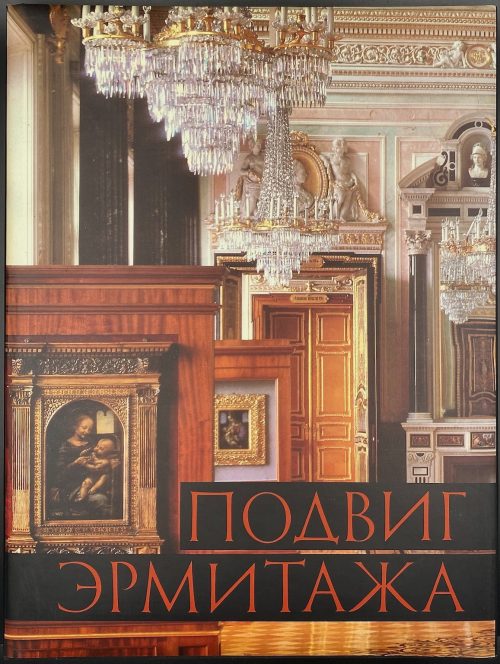 Title-page (in red on pictorial background): ПОДВИГ | ЭРМИТАЖА | ИЗДАТЕЛЬСТВО «АВРОРА» • ЛЕНИНГРАД || Illustrated album in hardcover, 33 x 25 cm, bound in black cloth with gilt and red to front cover and spine, brown endpapers, pictorial dust jacket; pp.: [1-6] 7-273 [274] [30], total 304 pages with 388 b/w and colour illustrations. Text: Sergei Petrovich Varshavsky [Сергей Петрович Варшавский] (Jewish-Russian, 1906 – 1980); B. Rest [Б. Рест; Юлий Исаакович Шапиро] (Jewish-Russian, fl. 1940 – 1980). Preface: Boris Piotrovsky [Борис Борисович Пиотровский] (Russian, 1908 – 1990). Layout by Liubov Rakhmilevich [Л. Рахмилевич]. Photography by Viktor Savik [В. Савик] and Leonid Bogdanov [Л. Богданов]. Design by Valery Ivanov [В. Иванов]. Russian twin edition to [LIB-3043.2022] S. Varshavsky, B. Rest. Saved for humanity: the Hermitage during the siege of Leningrad, 1941-1944. — Leningrad: Aurora Art Publishers, 1985 and [LIB-3042.2022] The ordeal of the Hermitage: The siege of Leningrad, 1941-1944 — Leningrad: Aurora Art Publishers, New York: Harry N. Abrams, Inc., 1985. The text extracted from [LIB-3035.2022] С. Варшавский, Б. Рест. Подвиг Эрмитажа: Государственный Эрмитаж в годы Великой отечественной войны. — М.-Л.: Советский художник, 1965.
Title-page (in red on pictorial background): ПОДВИГ | ЭРМИТАЖА | ИЗДАТЕЛЬСТВО «АВРОРА» • ЛЕНИНГРАД || Illustrated album in hardcover, 33 x 25 cm, bound in black cloth with gilt and red to front cover and spine, brown endpapers, pictorial dust jacket; pp.: [1-6] 7-273 [274] [30], total 304 pages with 388 b/w and colour illustrations. Text: Sergei Petrovich Varshavsky [Сергей Петрович Варшавский] (Jewish-Russian, 1906 – 1980); B. Rest [Б. Рест; Юлий Исаакович Шапиро] (Jewish-Russian, fl. 1940 – 1980). Preface: Boris Piotrovsky [Борис Борисович Пиотровский] (Russian, 1908 – 1990). Layout by Liubov Rakhmilevich [Л. Рахмилевич]. Photography by Viktor Savik [В. Савик] and Leonid Bogdanov [Л. Богданов]. Design by Valery Ivanov [В. Иванов]. Russian twin edition to [LIB-3043.2022] S. Varshavsky, B. Rest. Saved for humanity: the Hermitage during the siege of Leningrad, 1941-1944. — Leningrad: Aurora Art Publishers, 1985 and [LIB-3042.2022] The ordeal of the Hermitage: The siege of Leningrad, 1941-1944 — Leningrad: Aurora Art Publishers, New York: Harry N. Abrams, Inc., 1985. The text extracted from [LIB-3035.2022] С. Варшавский, Б. Рест. Подвиг Эрмитажа: Государственный Эрмитаж в годы Великой отечественной войны. — М.-Л.: Советский художник, 1965. -
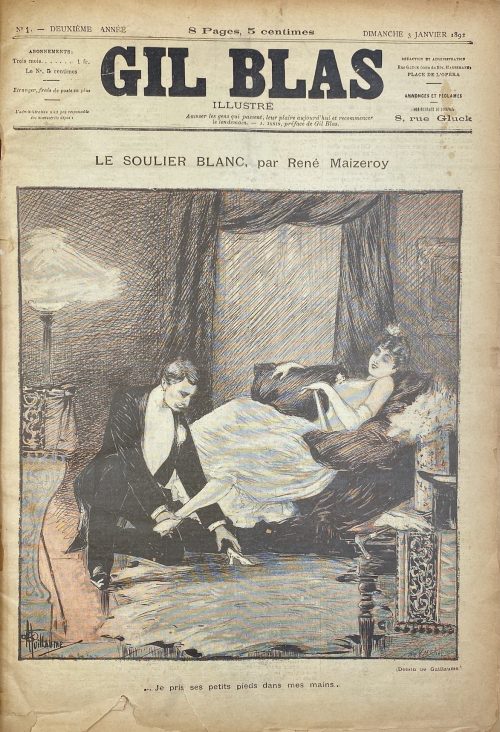 52 issues of French weekly Gil Blas illustré, 1892: №№ 1-52; published in Paris, 39 x 29 cm, bound in red half cloth over marbled boards, with gilt fillets and lettering to spine, marbled endpapers, profusely illustrated by Théophile Steinlen (Swiss-French, 1859 – 1923) and Albert Guillaume (French, 1873 – 1942).
52 issues of French weekly Gil Blas illustré, 1892: №№ 1-52; published in Paris, 39 x 29 cm, bound in red half cloth over marbled boards, with gilt fillets and lettering to spine, marbled endpapers, profusely illustrated by Théophile Steinlen (Swiss-French, 1859 – 1923) and Albert Guillaume (French, 1873 – 1942). -
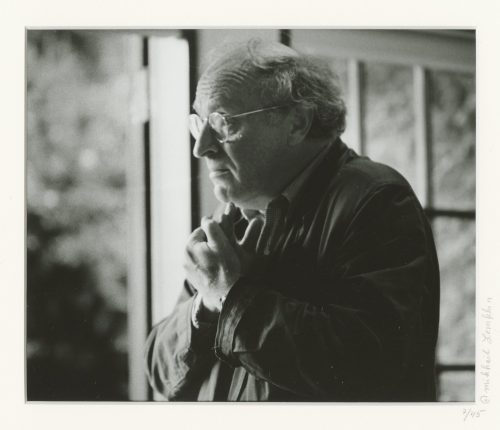 Photographic portrait of poet Joseph Brodsky, short half-length, turned to the left, with arms crossed on his breast. Pencil-signed on the mat: 7/45 • Mikhail Lemkhin; same inscription on the back of the print, and ink stamp ©Mikhail Lemkhin. Sitter: Joseph Brodsky [Иосиф Александрович Бродский ] (Russian-American-Jewish, 1940 – 1996). Size: mat: 35.7 x 43.3 cm; window: 19.5 x 23 cm; print: 20.3 x 25.3 cm.
Photographic portrait of poet Joseph Brodsky, short half-length, turned to the left, with arms crossed on his breast. Pencil-signed on the mat: 7/45 • Mikhail Lemkhin; same inscription on the back of the print, and ink stamp ©Mikhail Lemkhin. Sitter: Joseph Brodsky [Иосиф Александрович Бродский ] (Russian-American-Jewish, 1940 – 1996). Size: mat: 35.7 x 43.3 cm; window: 19.5 x 23 cm; print: 20.3 x 25.3 cm. -
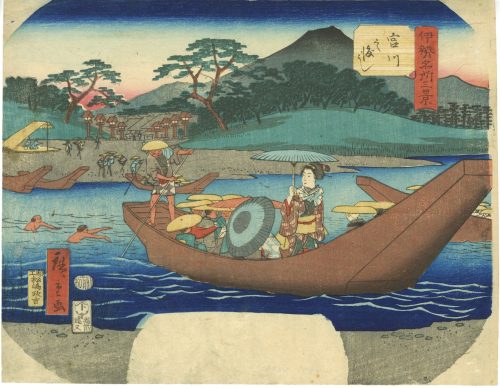 Artist: Utagawa Hiroshige II (二代目 歌川広重] (Japanese, 1826 – 1869). Signed: Hiroshige ga. Publisher: Enshūya Matabei [遠州屋又兵衛] (Japanese, fl. c. 1768 – 1881); (Enmata [遠又]), seal 22-009 (Marks). Block carver: Matsushima Masakichi (Japanese, fl. c. 1847-65); seal: [松嶋彫政] – Hori Masa (Frieze, 2009: 142). Combined date seal and kiwame censor seal: Bunkyū 2 (1862). Media: Fan print (uchiwa-e, 団扇絵), 230 x 298 mm Series: Three Famous Views in Ise [伊勢名所三景] (Ise meisho sankei).
Artist: Utagawa Hiroshige II (二代目 歌川広重] (Japanese, 1826 – 1869). Signed: Hiroshige ga. Publisher: Enshūya Matabei [遠州屋又兵衛] (Japanese, fl. c. 1768 – 1881); (Enmata [遠又]), seal 22-009 (Marks). Block carver: Matsushima Masakichi (Japanese, fl. c. 1847-65); seal: [松嶋彫政] – Hori Masa (Frieze, 2009: 142). Combined date seal and kiwame censor seal: Bunkyū 2 (1862). Media: Fan print (uchiwa-e, 団扇絵), 230 x 298 mm Series: Three Famous Views in Ise [伊勢名所三景] (Ise meisho sankei). -
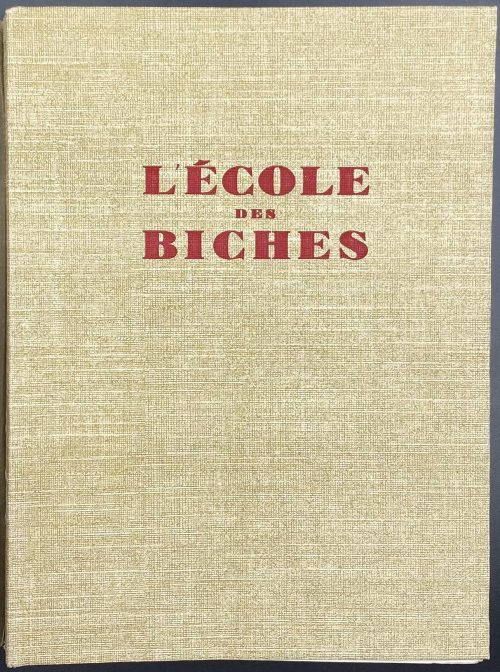 Softcover volume, 22.8 x 17 cm, French flapped wrapper simulating unprimed canvas with crimson lettering to front; pp.: ffl, [5/6] h.t., [7/8] t.p., 9-109 [110], [111/112] limitation/blank, ffl; plus 12 colour lithographs by Schem (Raoul Serres), incl. frontispiece; printed on wove paper. Title-page (red and black): L'ÉCOLE | DES | BICHES | OU | MŒURS DES | PETITES DAMES DE CE TEMPS | [blank] | M. CM. XXXIX. || Limitation: printed 99 copies of which this is № 27; date of printing July 10, 1939. Catalog raisonné: Dutel III № 1447. As per J.-P. Dutel (II № 231 pp 119-20), the text was published in Brussels in 1868 by Jean-Pierre Blanche. Presumed authors are Alfred Bégis, Frederick Hankey and Edmund Duponchel. [BEGIS, Alfred, with DUPONCHEL, Edmond, and HANKEY, Frederick, attributed to.] L'École des Biches ou Mœurs des petites dames de ce temps. Paris [but Brussels]: [Jean-Pierre Blanche,] 1863 [1868] sold at Christie’s for GBP 1,000 on November 18, 2014. For details, see [LIB-2812.2021] Highlights from the Erotica Library of Tony Fekete / Auction catalogue, Tuesday 18 November 2014. — London: Christie's, 2014. — Lot 36. Contributors: Alfred Bégis (French, 1829 – 1904) – author. Frederick Hankey (British, 1823 – 1882) – author. Edmund Duponchel (French, c. 1795 – 1868) – author. Jean-Pierre Blanche (Beligian, second half of the 19th century) – publisher. Schem [real name Raoul Serres] (French, 1881– 1971) – artist.
Softcover volume, 22.8 x 17 cm, French flapped wrapper simulating unprimed canvas with crimson lettering to front; pp.: ffl, [5/6] h.t., [7/8] t.p., 9-109 [110], [111/112] limitation/blank, ffl; plus 12 colour lithographs by Schem (Raoul Serres), incl. frontispiece; printed on wove paper. Title-page (red and black): L'ÉCOLE | DES | BICHES | OU | MŒURS DES | PETITES DAMES DE CE TEMPS | [blank] | M. CM. XXXIX. || Limitation: printed 99 copies of which this is № 27; date of printing July 10, 1939. Catalog raisonné: Dutel III № 1447. As per J.-P. Dutel (II № 231 pp 119-20), the text was published in Brussels in 1868 by Jean-Pierre Blanche. Presumed authors are Alfred Bégis, Frederick Hankey and Edmund Duponchel. [BEGIS, Alfred, with DUPONCHEL, Edmond, and HANKEY, Frederick, attributed to.] L'École des Biches ou Mœurs des petites dames de ce temps. Paris [but Brussels]: [Jean-Pierre Blanche,] 1863 [1868] sold at Christie’s for GBP 1,000 on November 18, 2014. For details, see [LIB-2812.2021] Highlights from the Erotica Library of Tony Fekete / Auction catalogue, Tuesday 18 November 2014. — London: Christie's, 2014. — Lot 36. Contributors: Alfred Bégis (French, 1829 – 1904) – author. Frederick Hankey (British, 1823 – 1882) – author. Edmund Duponchel (French, c. 1795 – 1868) – author. Jean-Pierre Blanche (Beligian, second half of the 19th century) – publisher. Schem [real name Raoul Serres] (French, 1881– 1971) – artist. -
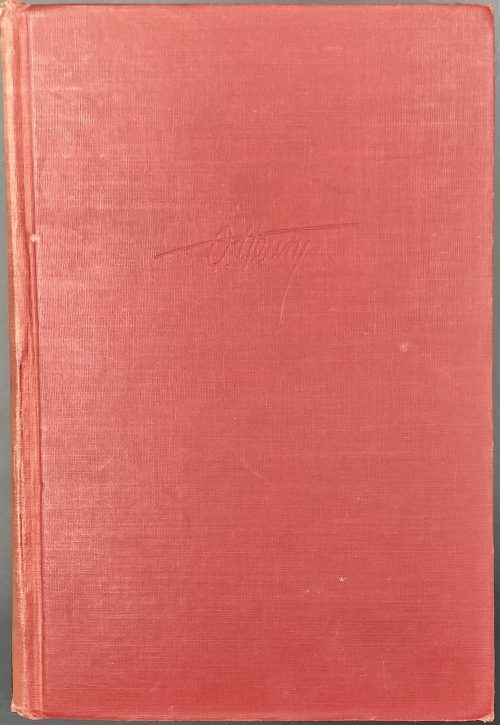 Hardcover volume, 21.5 x 14.7 x 5.7 cm, bound in red cloth with blind-stamped ms signature to front board and gilt lettering over black labels, and gild design elements to spine; pp.: [i-iv] (h.t./blank, t.p./copyright) v-xv[xvi] blank, [1-2] f.t./blank, 3-1653 [1654] blank, [2] publ. note/blank; 1672 pp total; Blue ink ms inscription to h.t. 'Lawrence Wyman'. Title-page (in a two-rule frame): THE COMPLETE WORKS OF | O. Henry | Foreword by | WILLIAM LYON PHELPS | AUTHENTIC EDITION | {publisher’s device, G.C.P.} | De Luxe Edition | — | Garden City Publishing Co., Inc. | GARDEN CITY NEW YORK || Contributors: O. Henry [William Sydney Porter] (American, 1862 – 1910) – author. William Lyon Phelps (American, 1865 – 1943) – author/foreword.
Hardcover volume, 21.5 x 14.7 x 5.7 cm, bound in red cloth with blind-stamped ms signature to front board and gilt lettering over black labels, and gild design elements to spine; pp.: [i-iv] (h.t./blank, t.p./copyright) v-xv[xvi] blank, [1-2] f.t./blank, 3-1653 [1654] blank, [2] publ. note/blank; 1672 pp total; Blue ink ms inscription to h.t. 'Lawrence Wyman'. Title-page (in a two-rule frame): THE COMPLETE WORKS OF | O. Henry | Foreword by | WILLIAM LYON PHELPS | AUTHENTIC EDITION | {publisher’s device, G.C.P.} | De Luxe Edition | — | Garden City Publishing Co., Inc. | GARDEN CITY NEW YORK || Contributors: O. Henry [William Sydney Porter] (American, 1862 – 1910) – author. William Lyon Phelps (American, 1865 – 1943) – author/foreword. -
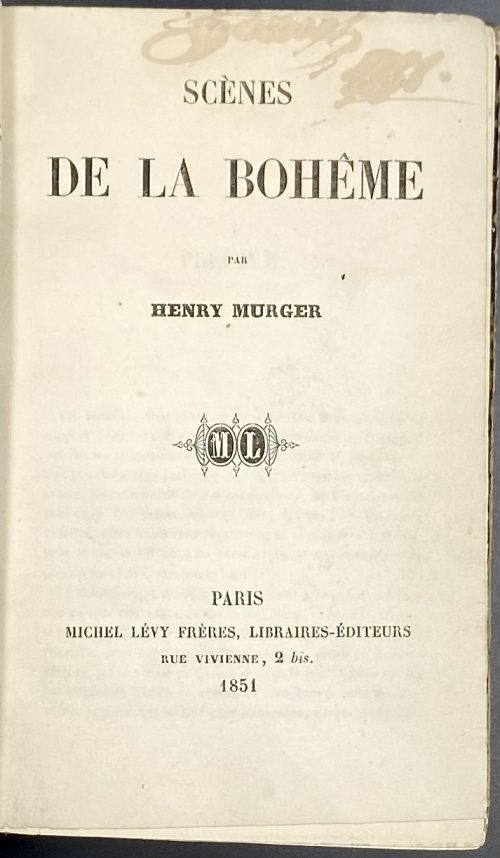 Hardcover volume, 18.2 x 11.8 cm, bound in quarter black polished calf with gilt lettering “cartonnage romantique” design to spine, marbled boards, matching marbled endpapers, blue margins. Title-page: SCÈNES | DE LA BOHÊME | PAR | HENRY MURGER | {publisher’s device ML} | PARIS | MICHEL LÉVY FRÈRES, LIBRAIRES-ÉDITEURS | RUE VIVIENNE, 2 bis. | 1851 || Half-title: ŒUVRES | D’HENRY MURGER || Advertisement: Chez le même Éditeurs. | BIBLIOTHEQUE CONTEMPORAINE | (page of text) || Collation: π2 (h.t/advert., t.p. / blank), 1-33 (17)12, χ6; total 212 leaves without ffls (3 front, 2 back). Pagination: [2] – h.t. / blank, [2] – t.p. / blank, [i] ii-xiii [xiv blank], [1] 2-406; total 424 pages. Scènes de la bohême, in later editions Scènes de la vie de bohème. Translations: Into English: LIB-2719.2021. Henri Murger. The Bohemians of the Latin Quarter. (Scènes de la vie de Bohême) / Translated from the French. — London: Vizetelly & Co., 1883. Into German: LIB-2686.2021. Henri Murger. Die Bohème : Szenen aus dem Pariser Künstlerleben. — Leipzig: Insel-Verlag, 1906. Into Russian: LIB-3182.2023. А. Мюрже. Сцены из жизни богемы / Пер. с франц. и прим. Е. А. Гунста; вст. ст. С. И. Великовского; художник Н. А. Кравченко. — М.: Художественная литература, 1963. Contributors: Murger, Henri [Henry] (French, 1822 – 1861) – author.
Hardcover volume, 18.2 x 11.8 cm, bound in quarter black polished calf with gilt lettering “cartonnage romantique” design to spine, marbled boards, matching marbled endpapers, blue margins. Title-page: SCÈNES | DE LA BOHÊME | PAR | HENRY MURGER | {publisher’s device ML} | PARIS | MICHEL LÉVY FRÈRES, LIBRAIRES-ÉDITEURS | RUE VIVIENNE, 2 bis. | 1851 || Half-title: ŒUVRES | D’HENRY MURGER || Advertisement: Chez le même Éditeurs. | BIBLIOTHEQUE CONTEMPORAINE | (page of text) || Collation: π2 (h.t/advert., t.p. / blank), 1-33 (17)12, χ6; total 212 leaves without ffls (3 front, 2 back). Pagination: [2] – h.t. / blank, [2] – t.p. / blank, [i] ii-xiii [xiv blank], [1] 2-406; total 424 pages. Scènes de la bohême, in later editions Scènes de la vie de bohème. Translations: Into English: LIB-2719.2021. Henri Murger. The Bohemians of the Latin Quarter. (Scènes de la vie de Bohême) / Translated from the French. — London: Vizetelly & Co., 1883. Into German: LIB-2686.2021. Henri Murger. Die Bohème : Szenen aus dem Pariser Künstlerleben. — Leipzig: Insel-Verlag, 1906. Into Russian: LIB-3182.2023. А. Мюрже. Сцены из жизни богемы / Пер. с франц. и прим. Е. А. Гунста; вст. ст. С. И. Великовского; художник Н. А. Кравченко. — М.: Художественная литература, 1963. Contributors: Murger, Henri [Henry] (French, 1822 – 1861) – author. -
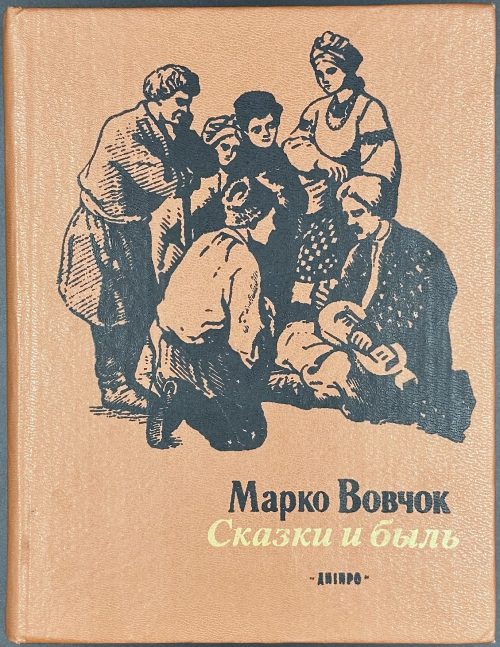 Small volume, 17.2 x 13.2 cm, brown buckram with vignette and lettering to front and spine, pp.: [1-4] 5-315 [5], illustrations: portrait, frontispiece, and two vignettes by I. Gavriliuk; text on Ukrainian and Russian. A reprint of the 1874 edition. Contents: Дев’ять братiв i десята сестриця Галя, Невiльничка, Ведмiдь, Кармелюк, Совершенная курица, Королевна Я, Затейник, Похождения домашнего учителя, Воришка, Чортова пригода. Title-page: Марко Вовчок | Сказки и быль | {vignette} | КИЕВ | ИЗДАТЕЛЬСТВО | ХУДОЖЕСТВЕННОЙ ЛИТЕРАТУРЫ | «ДНIПРО» | 1988 || Print run: 250,000 copies. Contributors: Марко Вовчок [Marko Vovchok; Марія Олександрівна Вілінська] (Ukrainian, 1833 – 1907) – author. Other variants: Markowovzok and Marko Vovtchok. Іван Михайлович Гаврилюк (Иван Михайлович Гаврилюк) (Ukrainian, 1939 – 2008) – artist.
Small volume, 17.2 x 13.2 cm, brown buckram with vignette and lettering to front and spine, pp.: [1-4] 5-315 [5], illustrations: portrait, frontispiece, and two vignettes by I. Gavriliuk; text on Ukrainian and Russian. A reprint of the 1874 edition. Contents: Дев’ять братiв i десята сестриця Галя, Невiльничка, Ведмiдь, Кармелюк, Совершенная курица, Королевна Я, Затейник, Похождения домашнего учителя, Воришка, Чортова пригода. Title-page: Марко Вовчок | Сказки и быль | {vignette} | КИЕВ | ИЗДАТЕЛЬСТВО | ХУДОЖЕСТВЕННОЙ ЛИТЕРАТУРЫ | «ДНIПРО» | 1988 || Print run: 250,000 copies. Contributors: Марко Вовчок [Marko Vovchok; Марія Олександрівна Вілінська] (Ukrainian, 1833 – 1907) – author. Other variants: Markowovzok and Marko Vovtchok. Іван Михайлович Гаврилюк (Иван Михайлович Гаврилюк) (Ukrainian, 1939 – 2008) – artist. -
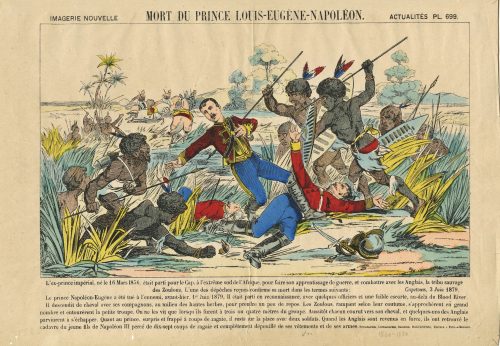 Hand-coloured lithography on wove paper, 275 x 385 mm; vertical centerfold, image in frame. On reverse: black ink stamp “5350”. Above the frame: "IMAGERIE NOUVELLE — MORT DU PRINCE LOUIS-EUGÈNE-NAPOLÉON. — ACTUALITÉS PL. 699". Under the frame: "L'ex-prince impérial, né le 16 Mars I856, était parti pour le Cap, à l'extrême sud de l'Afrique, pour faire son apprentissage de guerre, et combattre avec les Anglais, la tribu sauvage des Zoulous. L'une des dépêches reçues confirme sa mort dans les termes suivants: — Capetown, 3 Juin 1879. — Le prince Napoléon-Eugène a été tué à l'ennemi, avant-hier, 1er Juin 1879, Il était parti en reconnaissance, avec quelques officiers et une fable escorte, au-delà du Blood River. Il descendit de cheval ave ses compagnons, au milieu des hautes herbes, pour prendre un peu de repos. Les Zoulous, rampant selon leur coutume, s'approchèrent en grand nombre et entourèrent la petite troupe. On ne les vit que lorsqu' ils furent à trois ou quatre mètres du groupe. Aussitôt chacun court vers son cheval, et quelques-uns des Anglais parvinrent à s'échapper. Quant au prince, surpris et frappé à coups de zagaie, il resta sur la place avec deux soldats. Quand les Anglais sont revenus en force, ils ont retrouvé le cadavre du jeune fils de Napoléon III percé de dix-sept coups de zagaie et complétement dépouillé de ses vêtements et de ses armes". — "Typographie, Lithographie, Imagerie, Haguenthal, Éditeur à Pont-à-Mousson". Pencil ms: "1860-1880". Élie Haguenthal (French, 1822 – 1881) – publisher/printer.
Hand-coloured lithography on wove paper, 275 x 385 mm; vertical centerfold, image in frame. On reverse: black ink stamp “5350”. Above the frame: "IMAGERIE NOUVELLE — MORT DU PRINCE LOUIS-EUGÈNE-NAPOLÉON. — ACTUALITÉS PL. 699". Under the frame: "L'ex-prince impérial, né le 16 Mars I856, était parti pour le Cap, à l'extrême sud de l'Afrique, pour faire son apprentissage de guerre, et combattre avec les Anglais, la tribu sauvage des Zoulous. L'une des dépêches reçues confirme sa mort dans les termes suivants: — Capetown, 3 Juin 1879. — Le prince Napoléon-Eugène a été tué à l'ennemi, avant-hier, 1er Juin 1879, Il était parti en reconnaissance, avec quelques officiers et une fable escorte, au-delà du Blood River. Il descendit de cheval ave ses compagnons, au milieu des hautes herbes, pour prendre un peu de repos. Les Zoulous, rampant selon leur coutume, s'approchèrent en grand nombre et entourèrent la petite troupe. On ne les vit que lorsqu' ils furent à trois ou quatre mètres du groupe. Aussitôt chacun court vers son cheval, et quelques-uns des Anglais parvinrent à s'échapper. Quant au prince, surpris et frappé à coups de zagaie, il resta sur la place avec deux soldats. Quand les Anglais sont revenus en force, ils ont retrouvé le cadavre du jeune fils de Napoléon III percé de dix-sept coups de zagaie et complétement dépouillé de ses vêtements et de ses armes". — "Typographie, Lithographie, Imagerie, Haguenthal, Éditeur à Pont-à-Mousson". Pencil ms: "1860-1880". Élie Haguenthal (French, 1822 – 1881) – publisher/printer. -
 Three-quarter half-length seated portrait of American filmmaker and actor Woody Allen in a scene from the drama film The Front (1976), shot by Columbia Pictures in 1976, autographed on a light area of the image. Dimensions: 245 x 192 mm; image 217 x 192 mm.
Three-quarter half-length seated portrait of American filmmaker and actor Woody Allen in a scene from the drama film The Front (1976), shot by Columbia Pictures in 1976, autographed on a light area of the image. Dimensions: 245 x 192 mm; image 217 x 192 mm. -
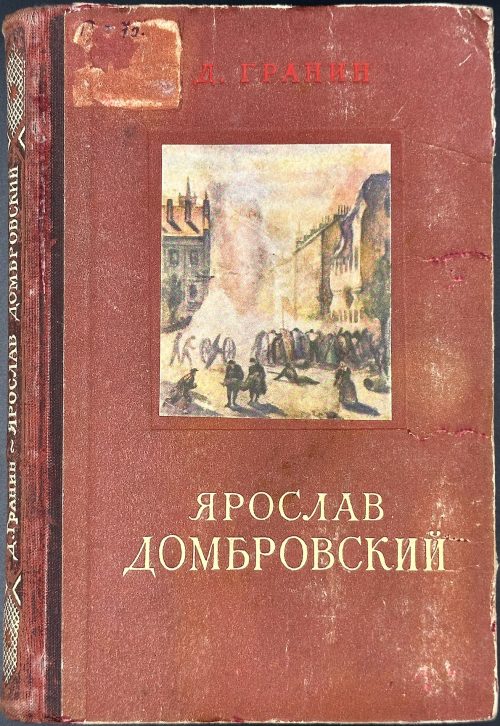 Hardcover, 20.4 x 14 cm, quarter burgundy cloth over paper boards with red and beige lettering and vignette to front and beige lettering to spine; pp.: [1-4] 5-182 [2], collation 8vo: 1-118 124, total 92 leaves. Design of binding and t.p. by В. Телепнев. Library pocket, stamps, and inscriptions. Title-page (red and black): Д. ГРАНИН | ЯРОСЛАВ | ДОМБРОВСКИЙ | ~ | ✸ | Издательство ЦК ВЛКСМ | “Молодая гвардия” | 1951 || Print run: 15,000 copies. Contributors: Даниил Александрович Гранин (Russian, 1919 – 2017) – author. Владимир Иванович Телепнев (Russian, 1906 – 1985) – artist. Jaroslaw Dombrowski [Jarosław Dąbrowski] (Polish-French, 1836 – 1871) – character.
Hardcover, 20.4 x 14 cm, quarter burgundy cloth over paper boards with red and beige lettering and vignette to front and beige lettering to spine; pp.: [1-4] 5-182 [2], collation 8vo: 1-118 124, total 92 leaves. Design of binding and t.p. by В. Телепнев. Library pocket, stamps, and inscriptions. Title-page (red and black): Д. ГРАНИН | ЯРОСЛАВ | ДОМБРОВСКИЙ | ~ | ✸ | Издательство ЦК ВЛКСМ | “Молодая гвардия” | 1951 || Print run: 15,000 copies. Contributors: Даниил Александрович Гранин (Russian, 1919 – 2017) – author. Владимир Иванович Телепнев (Russian, 1906 – 1985) – artist. Jaroslaw Dombrowski [Jarosław Dąbrowski] (Polish-French, 1836 – 1871) – character. -
 The right sheet of (optional) triptych: Geisha (Geiko) and kabuki actor Iwai Hanshirō V as Katanaya Hanshichi from Three pleasures of present-day Osaka (Tōsei Naniwa no sankō)「当世浪花の三興 芸子」 「刀屋半七」五代目岩井半四郎. Publisher: Iseya Rihei [伊勢屋利兵衛] (Japanese, fl. 1790s – c. 1879) Year: 1821 (Bunsei 4). Size: Vertical ōban; 36.5 x 25.2 cm. Signed: 於浮瀬亭国貞画 – Drawn by Kunisada in Ukabuse (Ukabuse ni oite Kunisada ga). Ukabuse is the name of a famous restaurant in Osaka, this signature can be found only on a three print bijin series [Kunisada Project]. Censor's seal: kiwame 改印:極 Actor Iwai Hanshirō V [岩井半四郎] (Japanese, 1776 – 1847); other names: Iwai Tojaku, Iwai Kumesaburō I. Character: Katanaya Hanshichi [刀屋半七] Ref: MFA ACCESSION NUMBER 11.21938; LIB-2967.2022 Izzard. Full series (triptych) Three Pleasures of Present-day Osaka (Tōsei Naniwa no sankō):
The right sheet of (optional) triptych: Geisha (Geiko) and kabuki actor Iwai Hanshirō V as Katanaya Hanshichi from Three pleasures of present-day Osaka (Tōsei Naniwa no sankō)「当世浪花の三興 芸子」 「刀屋半七」五代目岩井半四郎. Publisher: Iseya Rihei [伊勢屋利兵衛] (Japanese, fl. 1790s – c. 1879) Year: 1821 (Bunsei 4). Size: Vertical ōban; 36.5 x 25.2 cm. Signed: 於浮瀬亭国貞画 – Drawn by Kunisada in Ukabuse (Ukabuse ni oite Kunisada ga). Ukabuse is the name of a famous restaurant in Osaka, this signature can be found only on a three print bijin series [Kunisada Project]. Censor's seal: kiwame 改印:極 Actor Iwai Hanshirō V [岩井半四郎] (Japanese, 1776 – 1847); other names: Iwai Tojaku, Iwai Kumesaburō I. Character: Katanaya Hanshichi [刀屋半七] Ref: MFA ACCESSION NUMBER 11.21938; LIB-2967.2022 Izzard. Full series (triptych) Three Pleasures of Present-day Osaka (Tōsei Naniwa no sankō):


-
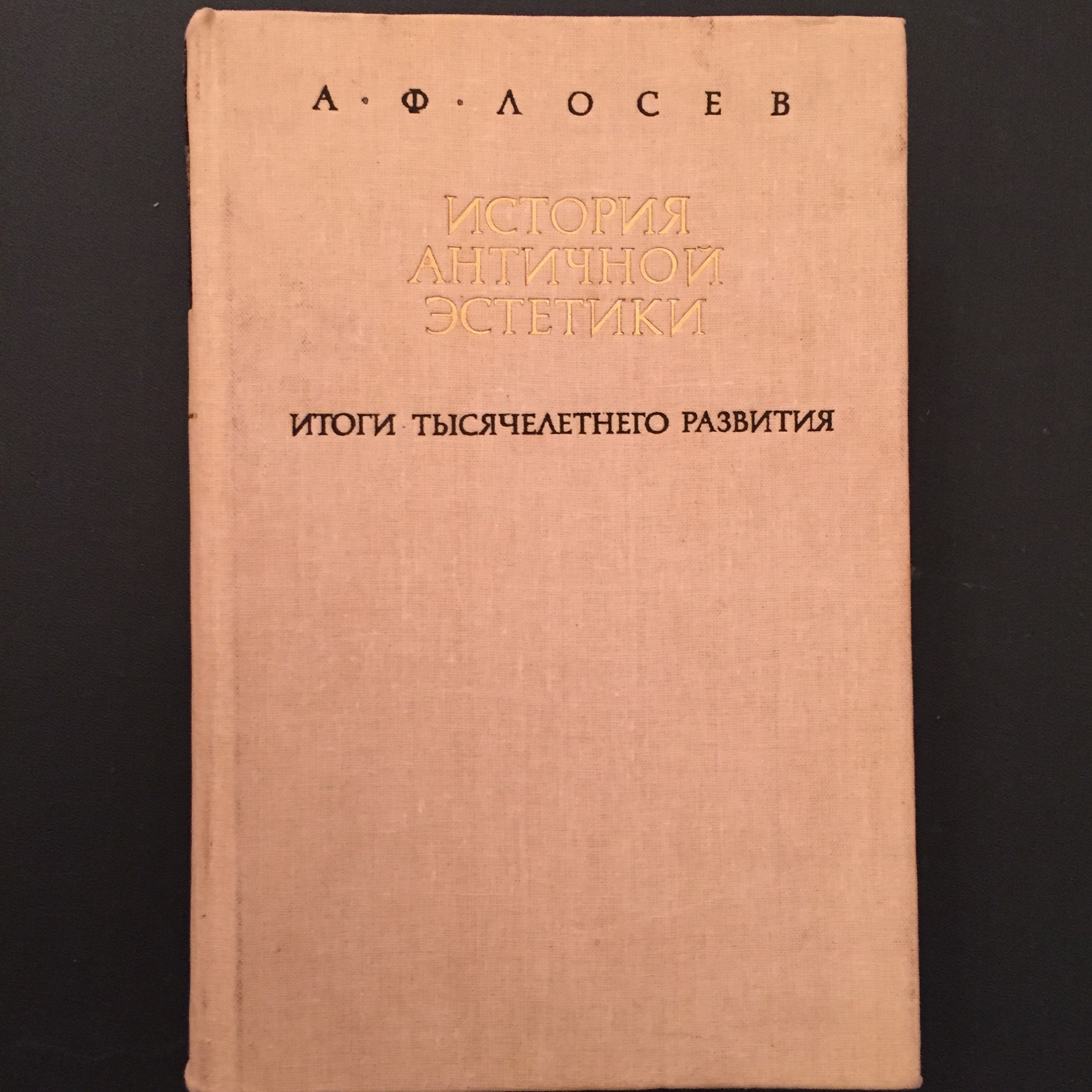
Л. Ф. Лосев. История античной эстетики. Итоги тысячелетнего развития: В 2-х книгах. Книга I. - М.: Искусство, 1992. -- 656 с. ISBN 5-210-02464-4 (кн. 1)
-
 Torii Kiyomitsu II (Kiyomine), Japanese, 1787–1868. Courtesan and her Komura (Doll Festival). Series: Furyu Goyo no Matsu (Customs of 5 Pine Needles, the 5 great festivals). Publisher: Tsuruya Kiemon [Marks: 553].
Torii Kiyomitsu II (Kiyomine), Japanese, 1787–1868. Courtesan and her Komura (Doll Festival). Series: Furyu Goyo no Matsu (Customs of 5 Pine Needles, the 5 great festivals). Publisher: Tsuruya Kiemon [Marks: 553]. -
 Artist: Utagawa Kunisada [歌川 国貞] a.k.a. Utagawa Toyokuni III [三代歌川豊国] (Japanese, 1786 – 1865). Publisher: Nishimuraya Yohachi [西村屋与八] (Japanese, fl. c. 1751 – 1860), seal name: Eijudō. Date: c. 1821–22 (Bunsei 4–5) Size: Ōban tate-e triptych, each sheet 36.8 x 26.4 cm. Signed: 五渡亭国貞画 – Gototei Kunisada ga (on center sheet). Censor’s seal: kiwame 改印: 極 A view of the dressing room of a Theater in Dōtonbori, Ōsaka (Ōsaka Dōtonbori shibai gakuya no zu): Right sheet: Actors Bandō Mitsuemon I, Asao Tamejūrō III, Ichikawa Danzō V, Nakamura Utaemon III, Bandō Mitsugorō III (in a costume of Matsuômaru), Kiriyama Monji III, Nakamura Utashichi II, Arashi Shôroku IV, Nakamura Matsue III, Matsumoto Kōshirō V, Ichikawa Komazō V. Centre sheet: Arashi Mitsugorō III, Mimasu Daigorō III, Nakayama Bunshichi III, Ichikawa Ichizō II, Bandō Minosuke II, Ichikawa Omezō I, Arashi Kitsusaburō I, Nakamura Utaroku I, Kataoka Nizaemon VII, Ōtani Tomoemon III, Asao Yūjirō I. Left sheet: Asao Kuzaemon I, Arashi Hidenosuke III, Sawamura Gennosuke II, Iwai Ōginosuke, Sawamura Kunitarō II, Iwai Matsunosuke I, Ichikawa Sōzaburō IV, Iwai Hanshirō V (in a costume of Sakuramaru), and Ichikawa Shinzō III (L). The actors are making up for a performance of the “Carriage-Stopping” scene from Sugawara Denju Tenarai Kagami (Sugawara Denju and the Secrets of Calligraphy). References: MFA Accession №: 11.43384a-c; Catalogue Raisonné: Izzard, Kunisada’s World (1993), #34; Hizô Ukiyo-e taikan/Ukiyo-e Masterpieces in European Collections 5, Victoria and Albert Museum II (1987), pl. 22; Keyes, PMA Osaka cat. (1973), #250 and pl. 15 (The theatrical world of Osaka prints, by Roger S. Keyes and Keiko Mizushima, Philadelphia Museum of Art, 1973), pp. 70-71); Izzard, Kunisada's world revisited, 2021; V&A Accession № E.5995-1886. Kabuki actors on this print: Arashi Hidenosuke III [嵐秀之助] (Japanese, fl. 1794 – 1837); other names: Arashi Koshichi IV, Arashi Hinasuke IV, Arashi Sanjūrō VI, Kanō Hidenosuke II, Kanō Umetarō, Arashi Iwajirō III. Arashi Kitsusaburō I [嵐橘三郎] (Japanese, 1769 – 1821); other names: Arashi Kichisaburō II, Arashi Rikan I. Arashi Mitsugorō III (Japanese, ? – ?) Arashi Shōroku IV [四代目嵐小六] (Japanese, 1783 – 1826) Asao Kuzaemon I [浅尾工左衛門] (Japanese, 1758 – 1824); other names: Asai Kuzaemon Nakayama Tashirō II Takeda Nisaburō. Asao Tamejūrō III [三代目淺尾爲十郎] (Japanese, 1780 – 1836); other names: Asao Okuyama III, Asao Okuyama III, Asao Tomozō I. Asao Yūjirō I [浅尾勇次郎] (Japanese, 1782 – 1835); other names: Jitsukawa Gakujūrō I, Asao Gakujūrō, Nakamura Yaozō, Asao Yaozō. Bandō Minosuke II [坂東蓑助] (Japanese, 1802 – 1863); other names: Morita Kan'ya XI, Bandô Mitsugorō IV. Bandō Mitsuemon I [坂東三津右衛門] (Japanese, 1788 – 1846); other names: Bandō Kumahei [坂東熊平]. Bandō Mitsugorō III [三代目 坂東 三津五郎] (Japanese, 1775 – 1831); other names: Bandō Minosuke I, Morita Kanjirô II, Bandō Mitahachi I, Bandō Minosuke I, Bandō Mitahachi I. Ichikawa Danzō V [市川団蔵] (Japanese, 1788 – 1845); other names: Ichikawa Shikō I, Ichikawa Danzaburō IV, Ichikawa Danjirō I, Ichikawa Morinosuke I. Ichikawa Ichizō II [市川市蔵] (Japanese, 1806 – 1829); other names Ichikawa Ebijūrō II, Ichikawa Sukezō I. Ichikawa Komazō V [市川高麗蔵] (Japanese, 1812 – 1849); other names: Matsumoto Kinshō I, Matsumoto Kōshirō VI, Matsumoto Kinshi. Ichikawa Omezō I [市川男女蔵] (Japanese, 1781 – 1833); other names: Ichikawa Benzō II, Ichikawa Bennosuke. Ichikawa Shinzō III [市川新蔵] (Japanese, 1793 – 1837); other names: Ichikawa Sumizō III, Nakayama Tomisaburô II, Nakayama Kinsha, Nakayama Tomisaburō II, Ichikawa Komazō IV, Ichikawa Santarō. Ichikawa Sōzaburō IV (Japanese, ? – ?) Iwai Hanshirō V [岩井半四郎] (Japanese, 1776 – 1847); other names: Iwai Tojaku, Iwai Kumesaburō I. Iwai Matsunosuke I [岩井松之助] (Japanese, 1804 – 1845); other names: Iwai Hanshirō VII, Iwai Shijaku I, Iwai Komurasaki I. Iwai Ōginosuke (Japanese, ? – ?) Kataoka Nizaemon VII [七代目片岡仁左衛門] (Japanese, 1755 – 1837); other names: Yamazawa Kunigorō, Asao Kunigorō II, Nakamura Matsusuke. Kiriyama Monji III [桐山紋治] (Japanese, fl. c. 1803 – 1830); other names: Ichikawa Takigorō. Matsumoto Kōshirō V [五代目松本幸四郎] (Japanese, 1764-1838); other names: Ichikawa Komazô III, Ichikawa Sumizô I. Mimasu Daigorō III [三枡大五郎] (Japanese, 1782 – 1824); other names: Mimasu Seibē, Yoshizawa Kamezō. Nakamura Matsue III [三代目中村松江] (Japanese, 1786-1855); other names: Nakamura Sankō I, Nakamura Tomijūrō II, Ichikawa Kumatarō. Nakamura Utaemon III [中村歌右衛門] (Japanese, 1778 – 1838); other names: Nakamura Tamasuke, Nakamura Baigyoku I, Nakamura Shikan I, Kagaya Fukunosuke I. Nakamura Utaroku I (Japanese, ? – ?) Nakamura Utashichi II (Japanese, ? – ?) Nakayama Bunshichi III [三代目目中山文七] (Japanese, 1764 – 1853); other names: Nakayama Hyakka, Nakayama Hyōtarō I, Nakayama Tokusaburō. Ōtani Tomoemon III [大谷友右衛門] (Japanese, 1793–1839); other names: Arashi Shagan IV, Arashi Sanpachi II, Nakayama Monzaburō. Sawamura Gennosuke II [沢村源之助](Japanese, 1802/7 – 1853); other names: Suketakaya Takasuke III, Sawamura Chōjūrō V, Sawamura Sōjūrō V, Sawamura Tosshō I, Sawamura Genpei I. Sawamura Kunitarō II [沢村国太郎](Japanese, 1798 – 1836); other names: Ogino Kinshi, Ogino Yaegiri III, Ogino Kamekichi, Izumikawa Kamekichi.
Artist: Utagawa Kunisada [歌川 国貞] a.k.a. Utagawa Toyokuni III [三代歌川豊国] (Japanese, 1786 – 1865). Publisher: Nishimuraya Yohachi [西村屋与八] (Japanese, fl. c. 1751 – 1860), seal name: Eijudō. Date: c. 1821–22 (Bunsei 4–5) Size: Ōban tate-e triptych, each sheet 36.8 x 26.4 cm. Signed: 五渡亭国貞画 – Gototei Kunisada ga (on center sheet). Censor’s seal: kiwame 改印: 極 A view of the dressing room of a Theater in Dōtonbori, Ōsaka (Ōsaka Dōtonbori shibai gakuya no zu): Right sheet: Actors Bandō Mitsuemon I, Asao Tamejūrō III, Ichikawa Danzō V, Nakamura Utaemon III, Bandō Mitsugorō III (in a costume of Matsuômaru), Kiriyama Monji III, Nakamura Utashichi II, Arashi Shôroku IV, Nakamura Matsue III, Matsumoto Kōshirō V, Ichikawa Komazō V. Centre sheet: Arashi Mitsugorō III, Mimasu Daigorō III, Nakayama Bunshichi III, Ichikawa Ichizō II, Bandō Minosuke II, Ichikawa Omezō I, Arashi Kitsusaburō I, Nakamura Utaroku I, Kataoka Nizaemon VII, Ōtani Tomoemon III, Asao Yūjirō I. Left sheet: Asao Kuzaemon I, Arashi Hidenosuke III, Sawamura Gennosuke II, Iwai Ōginosuke, Sawamura Kunitarō II, Iwai Matsunosuke I, Ichikawa Sōzaburō IV, Iwai Hanshirō V (in a costume of Sakuramaru), and Ichikawa Shinzō III (L). The actors are making up for a performance of the “Carriage-Stopping” scene from Sugawara Denju Tenarai Kagami (Sugawara Denju and the Secrets of Calligraphy). References: MFA Accession №: 11.43384a-c; Catalogue Raisonné: Izzard, Kunisada’s World (1993), #34; Hizô Ukiyo-e taikan/Ukiyo-e Masterpieces in European Collections 5, Victoria and Albert Museum II (1987), pl. 22; Keyes, PMA Osaka cat. (1973), #250 and pl. 15 (The theatrical world of Osaka prints, by Roger S. Keyes and Keiko Mizushima, Philadelphia Museum of Art, 1973), pp. 70-71); Izzard, Kunisada's world revisited, 2021; V&A Accession № E.5995-1886. Kabuki actors on this print: Arashi Hidenosuke III [嵐秀之助] (Japanese, fl. 1794 – 1837); other names: Arashi Koshichi IV, Arashi Hinasuke IV, Arashi Sanjūrō VI, Kanō Hidenosuke II, Kanō Umetarō, Arashi Iwajirō III. Arashi Kitsusaburō I [嵐橘三郎] (Japanese, 1769 – 1821); other names: Arashi Kichisaburō II, Arashi Rikan I. Arashi Mitsugorō III (Japanese, ? – ?) Arashi Shōroku IV [四代目嵐小六] (Japanese, 1783 – 1826) Asao Kuzaemon I [浅尾工左衛門] (Japanese, 1758 – 1824); other names: Asai Kuzaemon Nakayama Tashirō II Takeda Nisaburō. Asao Tamejūrō III [三代目淺尾爲十郎] (Japanese, 1780 – 1836); other names: Asao Okuyama III, Asao Okuyama III, Asao Tomozō I. Asao Yūjirō I [浅尾勇次郎] (Japanese, 1782 – 1835); other names: Jitsukawa Gakujūrō I, Asao Gakujūrō, Nakamura Yaozō, Asao Yaozō. Bandō Minosuke II [坂東蓑助] (Japanese, 1802 – 1863); other names: Morita Kan'ya XI, Bandô Mitsugorō IV. Bandō Mitsuemon I [坂東三津右衛門] (Japanese, 1788 – 1846); other names: Bandō Kumahei [坂東熊平]. Bandō Mitsugorō III [三代目 坂東 三津五郎] (Japanese, 1775 – 1831); other names: Bandō Minosuke I, Morita Kanjirô II, Bandō Mitahachi I, Bandō Minosuke I, Bandō Mitahachi I. Ichikawa Danzō V [市川団蔵] (Japanese, 1788 – 1845); other names: Ichikawa Shikō I, Ichikawa Danzaburō IV, Ichikawa Danjirō I, Ichikawa Morinosuke I. Ichikawa Ichizō II [市川市蔵] (Japanese, 1806 – 1829); other names Ichikawa Ebijūrō II, Ichikawa Sukezō I. Ichikawa Komazō V [市川高麗蔵] (Japanese, 1812 – 1849); other names: Matsumoto Kinshō I, Matsumoto Kōshirō VI, Matsumoto Kinshi. Ichikawa Omezō I [市川男女蔵] (Japanese, 1781 – 1833); other names: Ichikawa Benzō II, Ichikawa Bennosuke. Ichikawa Shinzō III [市川新蔵] (Japanese, 1793 – 1837); other names: Ichikawa Sumizō III, Nakayama Tomisaburô II, Nakayama Kinsha, Nakayama Tomisaburō II, Ichikawa Komazō IV, Ichikawa Santarō. Ichikawa Sōzaburō IV (Japanese, ? – ?) Iwai Hanshirō V [岩井半四郎] (Japanese, 1776 – 1847); other names: Iwai Tojaku, Iwai Kumesaburō I. Iwai Matsunosuke I [岩井松之助] (Japanese, 1804 – 1845); other names: Iwai Hanshirō VII, Iwai Shijaku I, Iwai Komurasaki I. Iwai Ōginosuke (Japanese, ? – ?) Kataoka Nizaemon VII [七代目片岡仁左衛門] (Japanese, 1755 – 1837); other names: Yamazawa Kunigorō, Asao Kunigorō II, Nakamura Matsusuke. Kiriyama Monji III [桐山紋治] (Japanese, fl. c. 1803 – 1830); other names: Ichikawa Takigorō. Matsumoto Kōshirō V [五代目松本幸四郎] (Japanese, 1764-1838); other names: Ichikawa Komazô III, Ichikawa Sumizô I. Mimasu Daigorō III [三枡大五郎] (Japanese, 1782 – 1824); other names: Mimasu Seibē, Yoshizawa Kamezō. Nakamura Matsue III [三代目中村松江] (Japanese, 1786-1855); other names: Nakamura Sankō I, Nakamura Tomijūrō II, Ichikawa Kumatarō. Nakamura Utaemon III [中村歌右衛門] (Japanese, 1778 – 1838); other names: Nakamura Tamasuke, Nakamura Baigyoku I, Nakamura Shikan I, Kagaya Fukunosuke I. Nakamura Utaroku I (Japanese, ? – ?) Nakamura Utashichi II (Japanese, ? – ?) Nakayama Bunshichi III [三代目目中山文七] (Japanese, 1764 – 1853); other names: Nakayama Hyakka, Nakayama Hyōtarō I, Nakayama Tokusaburō. Ōtani Tomoemon III [大谷友右衛門] (Japanese, 1793–1839); other names: Arashi Shagan IV, Arashi Sanpachi II, Nakayama Monzaburō. Sawamura Gennosuke II [沢村源之助](Japanese, 1802/7 – 1853); other names: Suketakaya Takasuke III, Sawamura Chōjūrō V, Sawamura Sōjūrō V, Sawamura Tosshō I, Sawamura Genpei I. Sawamura Kunitarō II [沢村国太郎](Japanese, 1798 – 1836); other names: Ogino Kinshi, Ogino Yaegiri III, Ogino Kamekichi, Izumikawa Kamekichi. -
 Kyo-sukashi iron tsuba of round form with design of hollyhock (aoi ) and wild geese. Slightly rounded rim. Copper sekigane. Momoyama period, late 16th - early 17th century. Height: 82.6 mm, Width: 82.1 mm, Thickness at seppa-dai: 4.5 mm. NTHK (Nihon Token Hozon Kai) certified.
Kyo-sukashi iron tsuba of round form with design of hollyhock (aoi ) and wild geese. Slightly rounded rim. Copper sekigane. Momoyama period, late 16th - early 17th century. Height: 82.6 mm, Width: 82.1 mm, Thickness at seppa-dai: 4.5 mm. NTHK (Nihon Token Hozon Kai) certified.






